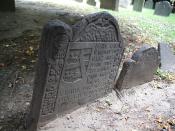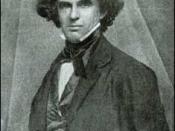Many works of literature contain much symbolic meaning. The Scarlet Letter, written by American author Nathaniel Hawthorne, contains many examples of these meaningful symbols. Published in 1850, this novel takes place in the Puritan colony of Boston, Massachusetts in the early seventeenth century. These symbols help convey the effects of sin on the individual. The sunshine, the forest, and Pearl have much significance as symbols.
The sunshine symbolizes things containing a good meaning. Claurice Swisher comments, "Sunlight suggests both truth and health" (162). The sun does not shine on Hester because of the sinful actions she performed. Her young daughter Pearl notices this: "Mother, the sunshine does not love you. It runs away and hides itself..." (Hawthorne 180; ch. 16). She realizes that the sunlight "avoids" her mother. Hester tries to grasp the sunshine in the forest, buy she cannot: when she "attempted to do so, the sunshine vanished" (81; ch.
16). Because of her sin, the sunshine will not even touch her. This creates a dark, gloomy overcast for her throughout the novel. The sunlight only shines on her once since she had Pearl. It is brief, and as Harold Bloom says, "The flood of sunshine that bathes Hester's uncovered head for a moment does not utter a full benediction of her sin, nor does it express the author's final comment on her moral state" (29). So even though the sunlight, representing truth and health, shines on her briefly, she does not possess freedom from her sin. For the rest of her life, and even after her death, she remains untouched by sunlight. The light on her grave shines "even gloomier than the shadow..." (Hawthorne 261; ch. 24). Although she has died, the sun still does not shine bright on her. The lack of sunshine surrounding Hester sets...


